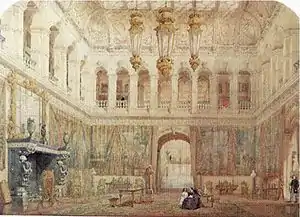Hannah Primrose, Countess of Rosebery
Hannah Primrose, Countess of Rosebery (née de Rothschild; 27 July 1851 – 19 November 1890) was the daughter of Baron Mayer de Rothschild and his wife Juliana (née Cohen). After inheriting her father's fortune in 1874, she became the richest woman in Britain. In 1878, Hannah de Rothschild married Archibald Primrose, 5th Earl of Rosebery, and was thereafter known as the Countess of Rosebery.
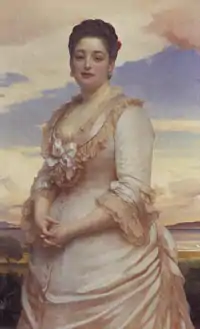
During the final quarter of the 19th century her husband, the Earl of Rosebery, was one of the most celebrated figures in Britain, an influential millionaire and politician, whose charm, wit, charisma and public popularity gave him such standing that he "almost eclipsed royalty."[1] Yet his Jewish wife, during her lifetime regarded as dull, overweight and lacking in beauty, remains an enigmatic figure largely ignored by historians and often regarded as notable only for financing her husband's three ambitions: to marry an heiress, win The Derby, and become Prime Minister (the second and third of these possibly apocryphal ambitions were achieved after her death).[2] In truth, she was her husband's driving force and motivation.
Her marriage into the aristocracy, while controversial at the time, gave her the social cachet in an antisemitic society that her vast fortune could not.[3] She subsequently became a political hostess and philanthropist. Her charitable work was principally in the sphere of public health and causes associated with the welfare of working-class Jewish women living in the poorer districts of London.
Having firmly assisted and supported her husband on his path to political greatness, she suddenly died in 1890, aged 39, leaving him, distraught and bereft of her support, to achieve the political destiny which she had plotted. His premiership of the United Kingdom was shambolic, and lasted barely a year. For over thirty years following her death, he wandered in a political wilderness, directionless and exceedingly eccentric, until his own death in 1929.
Early years

Hannah de Rothschild was born in 1851 into a world of great wealth and luxury. She was the granddaughter of Baron Nathan Mayer Rothschild, who had founded N M Rothschild & Sons, the English branch of the Rothschilds' banking empire. Niall Ferguson states in his History of the House of Rothschild that by the mid-19th century the Rothschilds regarded themselves as the nearest thing the Jews of Europe had to a royal family, and the equals of royalty.[5] Whether or not this was strictly true, the many Rothschild homes and their art collections, in England, Austria, France and Germany, certainly rivaled those of the crowned heads of Europe, Mentmore in particular being one of the most outstanding art collections of its kind anywhere in the world.[6]
Hannah de Rothschild's father Baron Meyer Amschel de Rothschild married his cousin Juliana Cohen in 1850. The marriage provided the impetus for Meyer to create what he described as "an enduring monument,"[4] a country house of monumental proportions. His daughter Hannah, aged just six months, laid the foundation stone on 31 December 1851.[7]
Within a few years of the mansion's completion, attracted by the good hunting and proximity to London, Hannah's relatives began to build estates nearby, all within a carriage drive of each other; thus, Hannah grew up in an almost private world of unimaginable splendour and security. Pevsner has described this enclave of Rothschild properties as "the most conspicuous and significant aspect of Victorian architecture in Buckinghamshire."[4] In addition to Mentmore, Baron and Baroness Meyer de Rothschild had a large house in London, 107 Piccadilly, and The Zenaide, a luxurious yacht, upon which Hanna's mother died in 1877, the year before her marriage. [8][9][10]
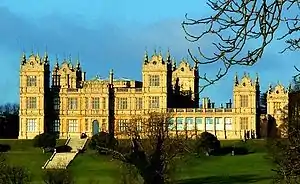
As an only child growing up in what were, in all but name, palaces, her childhood appears to have been lonely. She was a companion to her hypochondriac mother and, in later life, a hostess with her father during her mother's long periods of indisposition. She was indulged by both parents and her formal education was neglected in favour of music and singing lessons, subjects in which she was accomplished.[11][12] Her parents were very protective of her, attempting to ensure that she was never exposed to the risk of sickness or even the sight of poverty. As a result, she was never allowed to enter the cottages on the Rothschilds' estates.[13] A cousin, Constance Flower, Lady Battersea, who never liked her, claimed that Hannah was so sheltered that the phrase "the poor" was just a meaningless euphemism to her.[12] This is likely to be an exaggeration, as from her teens onwards she used much of her fortune to improve the lot of the poor, in housing and education. Whatever the faults of her education, she possessed great confidence, impressing her Rothschild relations, who noted her poise and competence when she hosted a large house party at Mentmore for the Prince of Wales while only 17 years of age.[12] A year later, in 1869, Hannah made her formal entrance into society as a debutante, when she was presented to Queen Victoria at Buckingham Palace by her mother.[14]
Mayer Amschel de Rothschild died in 1874, leaving his daughter not only Mentmore (with its priceless art collection), his London mansion, and innumerable investments, but also the sum of two million pounds sterling in cash (equivalent to £187 million in present day terms [15]). Thus, Hannah de Rothschild became the wealthiest woman in England.[16]
Betrothal
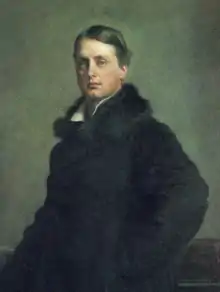
Hannah de Rothschild was first introduced to her future husband, the 28-year-old Earl of Rosebery, by Lady Beaconsfield, the wife of Benjamin Disraeli,[19] at Newmarket Racecourse.[20] The Disraelis were close friends and neighbours of the Rothschilds in Buckinghamshire.[21]
Archibald, 5th Earl of Rosebery, born in 1847, had inherited his title from his grandfather in 1868, aged 21, together with an income of £30,000 a year. He owned 40,000 acres (160 km²) in Scotland, and land in Norfolk, Hertfordshire, and Kent.[22] His father had died when he was eight and he had been brought up by his mother, who had subsequently married Harry Powlett, 4th Duke of Cleveland. His mother was a distant figure, and their relationship was always strained. The Earls of Rosebery, whose family name was Primrose, were old, if undistinguished, members of the Scottish aristocracy. Rosebery was considered to be strikingly handsome and immensely cultivated. He was highly intelligent, and a brilliant future was forecast for him by his tutors at both Eton and Christ Church, Oxford.[17]
As early as 1876, there were rumours of an engagement.[23] However, several hurdles had to be overcome before a marriage could take place. While the Jewish Rothschilds were accepted into society, and indeed were close friends of some members of the royal family including the Prince of Wales, as elsewhere in Europe, antisemitic feelings were prevalent in the upper echelons of society; particularly so among those closest to the Queen at court, where following the death of the Prince Consort in 1861 the Rothschilds became pointedly excluded.[24] The Queen's equerry Arthur Edward Hardinge referred to the Rothschilds' dining tables as "resplendent with the Hebrew gold" going so far as to say a visiting Russian royal needed a "corrective" visit to Westminster Abbey following acceptance of Rothschild hospitality.[24] Queen Victoria herself expressed antisemitic views in 1873 when it was proposed that Lionel de Rothschild be elevated to the peerage; the Queen refused, and expressed a reluctance to make a Jew a peer, saying that "to make a Jew a peer is a step she could not consent to" and furthermore stating that to give "a title and mark of her approbation to a Jew" was something she would not do.[25] Lord Spencer advised the Prince and Princess of Wales against attending a Rothschild ball with the words "The Prince ought only to visit those of undoubted position in Society."[24] However, this did not prevent the Prince from accepting Rothschild's invitations and gifts privately. While one could be friends with Jews and accept their hospitality, their social status was still not sufficiently elevated to include marriage into the peerage without unfavourable comment.[26][27]
Rosebery's own mother was horrified at the thought of a Jewish woman, even a Rothschild, in the family.[28] Rosebery too felt there was an impassable barrier of faith;[29] at this time, it was inconceivable that any children could be reared as Jews. Although it has been stated that Rosebery himself was devoid of any antisemitic views,[29] this was not always true, especially in later life.[30]
This factor also worked in reverse; while Hannah de Rothschild was keen to marry Rosebery, she was also aware of many obstacles, the foremost being that she was devoted to her faith, and to leave it would be a severe moral wrench.[31] Another obstacle was the Rothschild family itself: it was their custom to marry cousins[31] to keep their fortune within the family. Ironically, Hannah herself had opposed the marriage of her cousin Annie de Rothschild to the Christian Eliot Yorke, the son of the Earl of Hardwicke, in 1866.[32] In fact, she was to be the third daughter of the family's English branch to marry outside of the Jewish faith,[33] but such was the fame of the bridegroom and the resultant publicity that the Jewish elders and press felt an example needed to be made. The Jewish Chronicle announced its "most poignant grief" at the prospect, and cryptically added, "If the flame seize on the cedars, how will fare the hyssop on the wall: if the leviathan is brought up with a hook, how will the minnows escape,"[34] demonstrating what a threat to the social fabric of the Jewish faith the Jewish elders saw in the prospect of such a marriage. The quotation, originally from the Babylonian Talmud, can be taken to mean that the elders, respected, and more notable members of the Jewish faith should set a good example by strictly following the teachings of the Jewish articles of faith, which frown upon marriage to members of other religions.
The formal engagement of marriage was announced on 3 January 1878,[35] a day Rosebery forever afterwards regarded as sacred.[23] Writing to a friend in January 1878, Rosebery described his wife as "very simple, very unspoilt, very clever, very warm-hearted and very shy ... I never knew such a beautiful character."[16] The marriage was celebrated in London on 20 March 1878 at the Board Room of Guardians in Mount Street, and also in a Christian ceremony at Christ Church in Down Street, Piccadilly.[23] To show "official" disapproval, no male member of the Rothschild family attended the ceremonies.[32] However, any shortcomings in the guest list were compensated for by the guest of honour—the Prince of Wales—and Disraeli, who gave the bride away.
Marriage
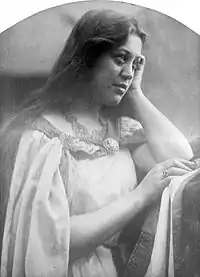
For the first few years following their marriage, the Roseberys resided in London in the Piccadilly house Lady Rosebery had inherited from her father. However, as the couple's social and political interests increased from 1882, they leased the larger Lansdowne House.[36] Lansdowne House was one of the finest of the aristocratic palaces in London, well suited to be the home of the political salon which Hannah Rosebery was to establish. Here political and social leaders of the day mixed with royalty, authors such as Henry James and Oscar Wilde, and other prominent social and intellectual figures of the time. Henry James, an occasional guest in the Roseberys' homes,[28] delivered one of the most unflattering condemnations of Lady Rosebery describing her as "...large, coarse, Hebrew-looking with hair of no particular colour and personally unattractive".[37]
The Roseberys divided their year among their various homes: London for the social season and parliament, Mentmore at weekends to entertain both political and shooting house-parties. In August the household would move north to Dalmeny for the grouse shooting. In between, occasional days and the weeklong Derby meeting would be spent at their home "The Durdans" in Epsom. Though small by comparison to their other homes, this mansion was described by Henry James as the most homely and comfortable of the Roseberys' many homes and as a delightful house full of books and sporting pictures, with just a few Gainsboroughs and Watteaux.[38] Together the Earl and Countess of Rosebery added greatly to not only the Mentmore collection but also to that housed at Dalmeny House, Rosebery's Scottish seat, amassing a great library of rare and continental volumes and a collection of artefacts formerly belonging to the Emperor Napoleon I.
Relationship with Rosebery
Published commentators on the Roseberys claim their marriage was happy, and there is no known evidence that Hannah was anything other than happy in her marriage, and quite a lot to suggest she was indeed blissfully happy.[39] However, much evidence suggests that Rosebery, while professing to be happy, was at times irritated and bored by Hannah, who was always keen to accommodate his every whim.[40]
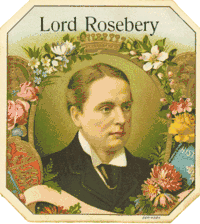
There were times when Lady Rosebery's devotion to her husband was tested. Rosebery may have not been antisemitic before his marriage; however, the acerbic wit for which he was famous led him to make remarks that could have been taken in such a way, once his marriage had secured the Rothschild fortune. Rosebery seems to have disliked his first son, who he claimed looked "Jewish."[28] On seeing his son for the first time he remarked "Le Jew est fait, rien ne vas plus,"[41] which must have been disconcerting for the child's Jewish mother. Rosebery, who has been described as febrile and supercilious,[42] replied in a letter of congratulations on the birth of his heir from Mary Gladstone: "I cannot pretend to be much excited by an event which occurs to almost every human being and which may cause me a great deal of annoyance." Rosebery then left his newborn child and wife (who was again pregnant) for a year-long tour of Australia. On another occasion, when the Roseberys were travelling in India, Rosebery is reported to have announced "I will travel ahead, Hannah and the rest of the heavy baggage will follow the next day."[43]
While the marriage was based on warmth and esteem on Rosebery's side and adoration on Hannah's,[23] it seems that Rosebery often found his wife's devotion irritating, and this sometimes caused him to be impatient with her. He was often abrupt with her in public.[44] She, by contrast, was completely enraptured by him, and would frequently ignore her neighbours at a dinner party to listen to her husband's conversation further down the table,[44] a faux pas almost considered a crime in Victorian society. Those who saw the couple alone at home "could not doubt the affection as well as the comprehension that united them."[44]
However, at times Rosebery's behaviour could be eccentric. Gladstone remarked that Rosebery was, perhaps, rather too concerned with his health.[45] Early in the marriage Rosebery decided to renovate the small ruined Barnbougle Castle (the original Rosebery family seat), close to, and within sight of, Dalmeny House. Once renovation was complete in 1882, Rosebery used it as a private retreat from his family, and began to spend his nights there alone. Always an insomniac, he claimed that the "stillness of the waters [the nearby Firth of Forth] were conducive to sleep."[46] Books were his passion, and he assembled a huge library in the small castle. Thus Rosebery was able to lead a life at Dalmeny with his wife, but also quite apart from her.
During their marriage the Roseberys travelled extensively, usually without their children. In September 1883 the couple left their children in the care of the nannies and nursery maids, supervised by Rosebery's sister Lady Leconfield, for a long tour of America and Australia.[47] Lady Rosebery owned large investments in North America, including ranches in Texas and mines in Montana. Their arrival in New York was widely reported, and a full and flattering description of Lady Rosebery was reported in The Herald. The newspaper went on to describe Rosebery as looking like a prosperous farmer. Lady Rosebery was very taken with California, from where she wrote: "The inhabitants are very entertaining ... the women are very handsome, think nothing of dresses costing £80, "fix up" their faces very frequently and are generally divorced."[48] Having toured and been fêted in America, the party moved on to Australia via Honolulu. In Australia, Rosebery chose to indulge his habit of solitude, installing his wife in a hotel in Sydney, while he went off alone to tour the outback.
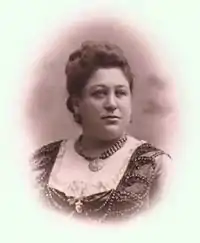
Rosebery's frequent absences from his wife fuelled gossip that he was a secret homosexual. It has been claimed that the inscrutable air that Rosebery wore was a mask to disguise his secret homosexual life.[49] The worry of this illegal secret, it was claimed, and fear of exposure, caused his insomnia and bouts of depression. It was even whispered that his Barnbougle Castle retreat was really a venue for clandestine assignations with young men. Rosebery's possible homosexuality has been much discussed in recent times. Nothing conclusive has ever been found one way or the other, but it is possible that he had homosexual experiences while in the care of a paedophile housemaster at Eton in his youth.[50] No evidence exists that his wife was aware of these rumours against her husband, or even that she would have understood them, bearing in mind her sheltered upbringing and limited education. Sex education was not part of a 19th-century upper-class girl's schooling.[51] The more public and precise accusations of Rosebery's homosexuality by the Marquess of Queensberry, following the Cleveland Street scandal, did not occur until three years after Lady Rosebery's death.
The relationship between the couple appears at times to have been almost that of a mother and child. Rosebery, a self-centred, reserved man, prone to depression, pessimism and insecurity, had a difficult relationship with his mother, who had been distant and openly preferred his younger brother.[52] Lady Rosebery, an orphan and only child, appears to have been desperate to lavish affection. Once upon entering a book shop she told her children they were entering a toy shop, and when the disappointed children pointed out the obvious she replied "to your father this is a toy shop."[53] Lord Rosebery's friend Edward Hamilton recorded her "notable faculty of getting other people to work and quickening their energies."[54] It seems she was the driving force of the relationship, with her feet firmly on the ground. She made herself the link between the world and her "thin skinned and neurotic" husband.[55] While her husband sulked or withdrew with hurt pride from a situation, she came to the forefront to plead his case or cause. If she was aware of his faults she gave no indication of it.
Children
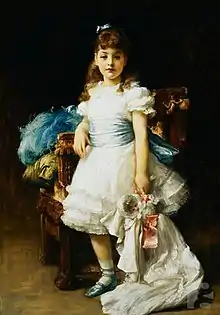
The marriage produced four children: Lady Sybil Primrose, born in 1879; Lady Margaret Primrose, born in 1881; the heir Harry Primrose, Lord Dalmeny (later 6th Earl of Rosebery), born in 1882; and finally the Honourable Neil Primrose, born the same year as his elder brother.
As a mother, Lady Rosebery was presented with a dilemma: she was in fact already practically a mother to her husband who had no great feeling for a proximity to small babies.[56] This was particularly evident in June 1880 when shortly after the birth of their first child Sybil, Rosebery wished to visit Germany for three months, to take a cure at a German spa (he was recovering from what is now thought to have been a nervous breakdown).[57] His wife dutifully accompanied him. However, Rosebery, clearly aware of his wife's frustrated maternal instincts, reported that Hannah savoured every detail of the daily letters from London concerning the baby, and that she never complained at the forced separation.[58]
More revealing is a comment Lady Rosebery herself made to her husband, "I sometimes think it is wrong that I have thought less of the children in comparison to you"[59] shortly before her death in 1890, suggesting that when a choice between her children and husband was forced on her, she always chose her husband. However, the same comment also hints that she was not unaware that her choice was at the cost of her children.
When assessing Lady Rosebery's behaviour to her children it should be remembered that she lived in an era of plentiful nannies, wet nurses, nursemaids and governesses which the upper classes employed as the norm. These people were employed regardless of the mother's affection towards her children; it was inconceivable that a countess would nurse her own children, and to do so would have been breaking social conventions. Hence her seeming lack of attention to her children was not unusual – she was following the upper class conventions and "stiff upper lip" philosophies of her era. However, in spite of their prolonged absences from their children, the Roseberys do not appear to have been very distant or remote figures in the earliest stages of their children's lives. Margot Asquith records how Rosebery loved to play and romp on the floor with the children.[60]
Politics
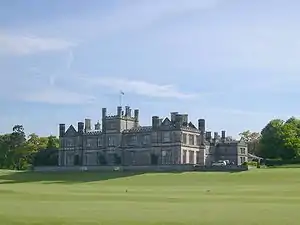
It has been said of Hannah de Rothschild that she grew up with a good sense and presence of mind, enabling her to deputise for her mother on grand social occasions at Mentmore and in London. This gave her confidence and the experience to be the perfect political wife.[61] Marriage to her altered Rosebery's status, too: while his wife acquired Christian respectability and a title, Rosebery moved from being one of many wealthy and capable young noblemen to being one with unfathomable riches.[62] This, coupled with his good looks, appealed to the public's imagination and gave him glamour.
From the outset of the marriage, political members of the Rothschild family took an interest in Rosebery,[63] and he was soon acclaimed as one of the rising hopes of the Liberal Party.[64] As a hereditary peer, he already had a seat in the House of Lords and had made his maiden speech there on attaining his majority. But brilliant as he was, Rosebery tended to lethargy and boredom. Lord Granville in fact considered Rosebery's wife to be the more ambitious of the pair,[40] and even advised her "If you keep him up to the mark, [he] is sure to have his page in history."[54] The subtle driving of her often languid and lethargic husband to achieve his "page in history" was to become her raison d'être.[40] Rosebery's secretary Thomas Gilmour noted: "She is thoroughly genuine and very tender and devoted to Lord Rosebery, it is easy to see that she is very proud of him, and she is a woman of considerable force of character and great energy, she may prove to be a powerful ally in his political career."[65] Rosebery was not a natural politician. He was an idealist who disliked the rancour of politics, in fact "his innate dislike of politics was something Lady Rosebery always fought against."[66] However, he was a gifted orator, and this was an era when platform speaking was beginning to replace House of Commons debate.[67] On a tour of America before his marriage, Rosebery had been impressed by the campaigning of prospective political candidates; in Britain little had changed in that respect since the hustings of the 18th century. He realised how an electorate could be swayed by a candidate touring his prospective constituency, aided by a well thought-out series of events, rallies and advertising, with the candidate's ideal and attractive family smiling by his side. Thus Lady Rosebery not only pushed and encouraged him behind the scenes but was now to become an encouraging and conspicuous figure by his side. In this way it could be said she was the first openly "political wife" in Britain.
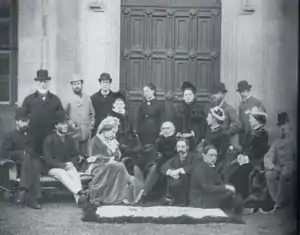
This first became evident in the great campaign to re-elect Gladstone. Known today as the Midlothian campaign, it was masterminded by the Roseberys. Rosebery used his influence to have Gladstone invited to stand as parliamentary candidate for Midlothian, near to Rosebery's Dalmeny estate. Gladstone had nominally retired from politics after losing his Greenwich seat in 1874, when Disraeli had been swept to power. The campaign was based at Dalmeny where Lady Rosebery hosted a series of large political house parties throughout the long campaign. The Tories were later to claim that Rosebery had paid for Gladstone's campaign. Rosebery later admitted to spending £50,000.[68]
The Roseberys' house party would leave Dalmeny and tour towns and cities across Midlothian and Scotland, with Gladstone and the speakers often addressing vast crowds from the back of an American-designed Pullman car specially acquired by Rosebery for the purpose. The scenes at these meetings have been described as something between a carnival and an evangelist's revival meeting.[69] While in the grounds of Dalmeny House itself, the public were treated to a great firework display.
Throughout all this, Gladstone was supported not only by the popular and charismatic Rosebery but also by an array of well-dressed women including Lady Rosebery and Gladstone's daughter Mary. These fashionable people – the celebrities of their day (newspapers at the time gave many column inches each day to the doings of the upper classes) – were as much a crowd-puller as the political speakers, and Rosebery's planning used that to full effect. One meeting was so packed that many were fainting: 70,000 people applied for tickets in a hall capable of holding 6,500.[70] Lady Rosebery reported, "I had never heard Archie (Lord Rosebery) speak in public politically before, but after the first minute I felt I could never be nervous at his making a speech the audience show him great affection." [sic][71] However it was not just Gladstone and Rosebery the huge crowds had come to see, but also the dutifully supporting and smiling families. Lady Rosebery went on to describe how "They (the crowds) patted me on the back till my shoulders were sensitive."[72] Thus in Rosebery's first serious involvement in politics, Disraeli was defeated and the newly elected MP for Midlothian became Prime Minister for the second time (the caretaker liberal leader Lord Hartington retired in favour of Gladstone). It was also obvious that Lady Rosebery was a very evident and valuable political electioneering asset. As the Marquess of Crewe put it "she had cut her spurs."[73]
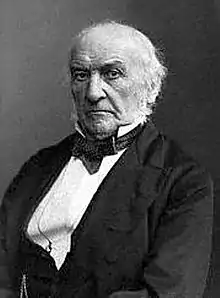
Her political mettle and ambitions for her husband were however to be more severely tested following the Liberal victory. Rosebery was, as expected, offered a position in Government by Gladstone. It had been rumoured that the position of Viceroy of Ireland or a cabinet place would be proffered,[75] but it turned out to be the job of Under Secretary of the India Office. Rosebery immediately declined the post, giving as his reason that it would appear that he was being repaid for running Gladstone's campaign (as though the Viceregal position would not). When pressed further he cited ill health—he had been suffering from scarlet fever during the Midlothian campaign and now also appeared to be suffering a minor nervous breakdown. Political leaders urged Lady Rosebery to influence him, but she defended his decision, while stressing that his deterioration in health was only temporary. She had to be careful—if it appeared her husband had declined the offer on the grounds that it was too lowly, it would give substance to the claims being made that he was conceited and petulant. Whatever the truth, and it may be Rosebery's own explanation that he "disliked hard work,"[57] Lady Rosebery continued to solicit Gladstone for a job for Rosebery within the cabinet. In August 1880, when Gladstone told her firmly that "There is nothing I can give him," she claimed she had not been seeking a cabinet post and Gladstone had misunderstood her.[73] At the same time she was canny enough to mention that Sir William Harcourt and Sir Charles Dilke, both radicals opposed to Gladstone's policies, were "visiting them" and "thoughtful."[73] Lady Rosebery also began to befriend those politicians such as Lord Northbrook who empathised with her husband, while others such as Lord Granville and Lord Hartington she identified as aloof. She dismissed Lord Spencer with "I can never look on him as a great motive power, besides he does not mention Archie [Rosebery] to me."[76] This was the same Lord Spencer who had advised the Prince and Princess of Wales against visiting the homes of wealthy Jews.
Finally her soliciting paid off and in 1881, Rosebery was offered a government position acceptable to him, that of Under Secretary at the Home Office with special responsibility for Scotland. He had sought the position feeling that Scotland was neglected by the Liberal Government who were more interested in Ireland.[72] However, immediately upon assuming the job he began to demand a place in the cabinet. The office he sought was that of Lord Privy Seal, a position Gladstone refused on account of Rosebery's inexperience in Government. It appeared that Rosebery was showing his true colours and he was accused of behaving like a spoilt child, with doubts cast over the honourableness of his reasons for refusing the Under Secretaryship of the India Office.[77] Lady Rosebery, "conscious of her husband's supreme ability,"[78] wanted him in the cabinet and was furiously agitating her husband's discontent until Rosebery threatened to resign his Home Office position. Lady Rosebery had an angry row with Gladstone's wife,[78] where Mrs Gladstone pointed out that if Rosebery resigned he would have nothing but horse racing to interest him, and that Lady Rosebery should be patient as her husband was young. Rosebery, accepting that a cabinet place was not going to be forthcoming, resigned from Government. Lady Rosebery, realising further appeal to the Gladstones was pointless, tried a new avenue—Lord Hartington, the immensely influential Secretary of State for War, who was already quarrelling with Gladstone over the Irish home rule problem, and whom she allegedly met by chance at Preston Railway Station. Inviting him into her carriage for the journey to London, she pleaded her husband's case for three hours to her captive listener.[79] The Roseberys then immediately left England and their children for a long trip to America and Australia. On their return in 1885 Rosebery was appointed Lord Privy Seal, complete with the seat in the cabinet which he sought.
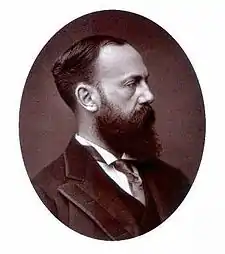
Gladstone resigned as Prime Minister in 1885 following a Government defeat over the Irish home rule question. The new Tory government was led by Lord Salisbury. However, as a minority administration it was not expected to last, and a swift return of the former administration was anticipated. During this period serious (if unproven) charges of plotting and ruthless ambition were about to be levelled against Lady Rosebery. Sir Charles Dilke, considered as a likely replacement for Gladstone,[80] and thus a rival to Rosebery in government, was implicated in one of the most scandalous and ruinous divorce cases of the era. Involvement in any divorce was social suicide in the 19th century, but the facts which emerged were enough to ensure it was political suicide as well. A friend of the Roseberys, Donald Crawford, MP, sued his wife Virginia for divorce naming Dilke as co-respondent. There was little evidence and Dilke denied the charge, which could have been ultimately forgotten, if Virginia had not suddenly decided to sign a confession giving such lurid details that a great scandal was unavoidable. She claimed that not only had Dilke slept with her and taught her "French vices", but also slept with her mother and partaken in a three-in-a-bed orgy with Virginia and a maid.[81] Dilke denied everything, but his hopes of high political office were ruined forever. Dilke claimed the whole thing was an embroidery of lies and conspiracies by his political enemies. Rumours began to circulate that the Roseberys, and Lady Rosebery in particular, were at the bottom of Dilke's misfortune.[82] In his futile quest to exonerate himself, and grasping at rumour, Dilke wrote to Rosebery accusing Lady Rosebery of having paid Virginia to make the confession. An outraged Rosebery denied all on his wife's behalf,[83] while in December 1885 Lady Rosebery's only response on being told of Virginia Crawford's confessions was: "Dilke's behaviour is very astonishing in some reports, though it is not an actual surprise to me."[84] Early the following year Gladstone was returned to power and Rosebery was appointed Foreign Secretary in Gladstone's third but brief term of office. Dilke's political career was ruined, and for years afterwards he continued to expound the Rosebery conspiracy theory. Nothing was ever proven against Lady Rosebery and no tangible evidence exists to substantiate the claim.
The impartiality demanded by Rosebery's new office forced him to sell many of his business interests, which had come by the way of the Rothschild family, to be seen to be avoiding a conflict of interest. However, his wife's ambition and part in his rise to power was not only being recognised in high places, but clearly starting to irritate. On being told that Lady Rosebery was very keen for her husband to become Foreign Secretary, Gladstone replied "She would think herself capable of being Queen of the Realm and think the place only just good enough for her."[85] Rosebery was now on the path to political greatness, but Gladstone's government fell the same year. Lady Rosebery was not to see her husband achieve the highest political office.
Philanthropy

Like many other women of her class and era, Lady Rosebery patronised a great number of charities.[86] Upon her inheriting her fortune, one of her first acts was to found a lifeboat station in memory of her father, in 1875, at a cost of £2,000.[87] However, her chief causes appear to have all been connected specifically to the assistance and welfare of women. She was president of the Scottish Home Industries Association, a charity which encouraged Scottish women to work profitably from home making plaid or other items of needlework and the like. In this way women, especially widowed mothers, remained in their homes able to care for their often large families while still earning an income.
Queen Victoria appointed her president of the Queen Victoria Jubilee Institute for Nurses in Scotland, the beginning of the district nurse system, which was to revolutionise health care for the rural poor and sick in Britain. She was also interested in general improvements in standards of nursing.
Like many of her Rothschild relatives she was also deeply involved with the welfare of young working-class women of the Jewish faith who inhabited the poorer areas of London, in particular Whitechapel. There she founded the Club for Jewish Working Girls. She also donated to numerous other charities connected with Jewish causes. However, within a week of her death her husband began to cancel many of these subscriptions, prompting charges of antisemitism.[88]
Her interest in education has been one of her most obvious surviving charitable legacies. She founded schools in all the villages surrounding the Roseberys' estates. The Mentmore estate alone was serviced by three schools founded by her at Wingrave, Cheddington and Mentmore itself. Not only were the children educated at her expense by trained teachers, each was also provided with seasonal gifts of new clothes. Cheddington School remains in its original building with her cypher on its walls, while Wingrave School, which opened in 1877, survives in new premises.[89]
One of her more pioneering and innovative charitable causes was the oral instruction of what were then called the deaf and dumb.
Death and legacy
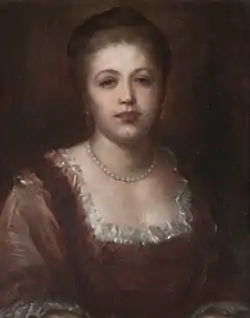
Lady Rosebery died of typhoid at Dalmeny in 1890.[91] She fought the disease, but it was found that she was also suffering from Bright's disease, which had weakened her, making it impossible to survive the attack. She was buried in accordance with the rites of the Jewish faith. Rosebery found this particularly hard to bear, and wrote to Queen Victoria of the pain he experienced when "another creed steps in to claim the corpse."[92] It was only after her death that the doctors who had treated her disclosed to Rosebery that her kidney condition would have killed her within two years even if she had not contracted typhoid.[44]
Her funeral was held on 25 November 1890 at Willesden Jewish Cemetery. As is the Jewish tradition, the service was attended only by male mourners, who included most members of Gladstone's cabinet.
There is no evidence that Lady Rosebery drove her husband to follow her own political agenda, or that of her family. For her the rewards seem to have been the pleasure of seeing a husband she undoubtedly adored in the high office of which she felt him worthy. There is no doubt that she tempered her husband's more radical views. Immediately following his wife's death Rosebery retired from politics, writing in October 1891 "The sole object of my ambition has disappeared with the death of my wife."[93] Proof of the widespread belief in society that Lady Rosebery was the stable element of the partnership was confirmed shortly after her death, by Queen Victoria, following a then rare public speech by Rosebery, in which he supported Home Rule for Ireland. The Queen was shocked and thought the speech "almost communistic" and went on to attribute Rosebery's "shocking and disappointing" behaviour to the fact that "poor Lady Rosebery is not there to keep him back."[94] While Queen Victoria always personally liked Rosebery, she mistrusted his politics.[95] The Queen had thoroughly liked Lady Rosebery and wrote Rosebery several letters of condolence, likening his loss to the untimely death of her own consort, Prince Albert.[96] It seems that the Queen's antipathy to Jews was confined to elevating them to the peerage. This view had softened by 1885.[97] In 1890 she accepted a luncheon invitation from Lady Rosebery's cousin Ferdinand de Rothschild and toured Waddesdon Manor albeit eating in a separate dining room to the Jewish members of the party.[98]
Shortly after his wife's death, Rosebery left his grieving children and went alone on a tour of Spain. Following a visit to El Escorial he wrote on the sepulchral wonders of the building, but added "for the dead alone the Taj is of course supreme."[99] On his return home he had designed for his wife a Victorian Gothic version of the Taj Mahal in miniature. For the remainder of his life he wore black and used black edged writing paper. Once, when talking with his daughter Sybil, he asked her what mourning she thought her mother would have worn had the situation been reversed. Sybil replied, "She would not have worn any, she would have died at once."[100]
Ronald Munro Ferguson has been quoted in 1912 as saying "many things would have gone otherwise had Lady Rosebery lived. Her loss is today as great a calamity from every point of view as it was at the time of her death."[66]
Widowhood changed Rosebery, both mentally and physically: he aged overnight, and began to refer to himself as an old man.[66] Two years after her death, friends were still concerned that he was suicidal. Winston Churchill thought him maimed by her death, and later said of her "she was a remarkable woman on whom Rosebery leaned, she was ever a pacifying and composing element in his life which he was never able to find again because he could never give full confidence to anyone else."[101]
Sir Edward Hamilton, Rosebery's closest friend, wrote:
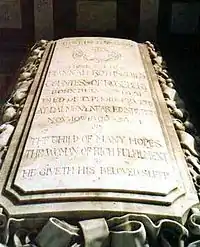
Her judgement of a whole was singularly sound and calm; indeed there was a sort of intuitive wisdom about the advice which she would recommend or the consequences of which she would foretell. Hers was a singularly well balanced mind; her shrewdness and foresight were most certainly to lead others as well as herself to form right conclusions. Having the power of seeing through people quickly, she gauged the characters of her fellow creatures with great perspicacity and she thus knew whom to trust and of whom to beware. She had a high sense of duty and would never allow pleasure to interfere with duty.[104]
Her qualities were portrayed in literature when Lady Rosebery was reputed to be the model for Marcella Maxwell in Mrs Humphry Ward's novels Marcella (1894)[105] and Sir George Tressady (1909).[54][106] The author lived at Stocks[107] close to Lady Rosebery's home at Mentmore and would certainly have known her, while in the books Marcella's house is based on Hampden House, also in Buckinghamshire.
The Liberals did not return to office until 1892. Lord Rosebery was eventually persuaded to enter government, becoming once again Foreign Secretary serving under Gladstone as Prime Minister. In 1894 on Gladstone's retirement he achieved his wife's ambitions and became Prime Minister, but by then Lady Rosebery was dead. Without her, Rosebery was a shadow of his former self, taking huge doses of morphine to combat insomnia and nerves. His Prime Ministership lasted barely a year, marred by problems and difficulties. For the remainder of his life and without his wife, as Queen Victoria phrased it, "to hold him back", he became more and more eccentric and controversial in his decisions. His final years were blighted by ill health and a self-enforced seclusion in Scotland. He died in 1929.
Before their marriage and his full-time entry into politics, Rosebery's future wife had written with extraordinary foresight and ambition to him: "I work only to help you, if you are Prime Minister, let me imitate Montagu Corry."[108] Corry had been Disraeli's influential private secretary on whom he had relied. Rosebery only ever trusted his wife. Without her to calm and order his life he was a neurotic wreck.
Lady Rosebery's eldest son, Harry, who was less successful in politics than his father and brother, distinguished himself by becoming captain of Surrey County Cricket Club and owning two Epsom Derby-winning horses. He succeeded his father as 6th Earl of Rosebery and died in 1974. Margaret married her father's old friend and biographer the Marquess of Crewe. Such was still the fame of her parents that London traffic was brought to a standstill on her wedding day in 1899.[109] Lady Crewe became one of the first women magistrates in Britain; she died in 1955. Lady Sybil has been summarised by one of her father's biographers: "Even more eccentric than her father, she spent much of her time living in a caravan."[109] Neil, the second of the Roseberys' sons, entered politics and a promising future was foretold for him. However, on the outbreak of World War I he joined the army, and was killed leading a charge at Gezer in 1917.
Of Hannah Rosebery's homes, the lease on Lansdowne House was surrendered shortly before her death, when the Roseberys purchased 38 Berkeley Square. This property was transformed into one of London's most luxurious town houses. However, Lady Rosebery did not live to see the work completed. Her son Harry sold the house in 1938, and it was demolished. A year later a bomb landed on the empty site during World War II.[110] The Durdans was bequeathed to her daughter, Sybil, in 1929 and was sold together with its contents in 1955. Lord and Lady Rosebery's library there was given to the nation at this time. Mentmore, the grandest of the Roseberys' homes, was sold by Lady Rosebery's grandson, the 7th Earl of Rosebery, in 1977, together with the Rothschild art collection, which Lady Rosebery had not only been intensely interested in but had enlarged considerably. She personally catalogued the collection, and prophetically wrote in the preface "In time to come, when, like all collections, this will be dispersed (and I hope this will be long after my death) this book may be of value."[111] Her two-volume work and the collection it described remained so unknown that "Save Mentmore" (a group attempting to halt the sale of Mentmore to keep the collection within Britain[112]) failed largely due to widespread public ignorance of both house and collection. A few pieces of furniture and paintings were taken to Dalmeny, (the only house to remain in the family) where they are displayed today, and three pictures including Drouais' Madame de Pompadour were purchased for the National Gallery. The remainder of the collection was dispersed in a week-long sale and is now scattered across the globe. A further sale of the "Continental Library," to which she had added, was conducted in 1995 at the Aeolian Hall, London by Sotheby's.[113]
Today, Hannah, Countess of Rosebery is only referred to in biographies of her husband or better known Rothschild relations; no published biography of her has been written. Her husband, once one of the "most celebrated figures in Britain,"[1] is now regarded as one of Britain's less successful Prime-Ministers. Thus Hannah, Countess of Rosebery, in her day celebrated in the worlds of politics, philanthropy, and high society, has become a historical footnote to her husband's better documented career.
Notes
- McKinstry, p. 1.
- McKinstry, p. 540, footnote 35, explains that there is no written record of the often quoted ambition. It is frequently thought to have been conceived at Eton. The author Robert Rhodes James in his biography of Rosebery (published in 1995, ISBN 1-85799-219-9) has argued that it is apocryphal. McKinstry (p. 540) considers that if it was conceived by Rosebery, he probably told it to Samuel Ward, the American political lobbyist, at a meeting of the Mendacious Club during the 1870s. The ambition is told as fact in Samuel Ward's biography Sam Ward, King of the Lobby by Lately Thomas, published in 1965 (Cambridge, Mass).
- Young, P 18, in his authorised biography of Lady Rosebery's son states "Most people at the time (of Hannah Rosebery's marriage) were casually antisemitic, despite the Prince of Wales hob-nobbing with Jewish financiers".
- Robinson, p. 5.
- Ferguson, p. 771.
- Mentmore; Sir Frances Watson KCVO; Sotheby Parke Bernet & Co, London, 1977
- Robinson, SAVE Mentmore for the Nation, p. 5 reports her laying the foundation stone. The ceremony of laying of a foundation stone is purely ceremonial, and merely requires the person chosen to touch the stone with a trowel in hand.
- Cardiff Times; Saturday 07 February 1874
- Deirdre, Lady Rosebery, p.28.
- Deidre, Lady Rosebery, in her history of Dalmeny House gives the name of the yacht as Zenaide; however, contemporary reports of Baroness Meyer's death name the yacht as Czarina (see:Cheltenham Looker-On - Saturday 17 March 1877). Several items of table silver from the yacht in the Mentmore sale of 1977, were also engraved "Czarina" (See Mentmore Vol II; p 220). The yacht was later brought by Mr Albert Brassy (See: Northern Whig - Monday 06 September 1886)
- McKinstry, p. 69.
- McKinstry, p. 70.
- McKinstry, p. 69, quotes Hannah's cousin Constance de Rothschild (the wife of Lord Battersea) as saying "She was never allowed to enter a cottage, to go where sickness and sorrow dwelt."
- London Evening Standard - Wednesday 12 May 1869
- UK Retail Price Index inflation figures are based on data from Clark, Gregory (2017). "The Annual RPI and Average Earnings for Britain, 1209 to Present (New Series)". MeasuringWorth. Retrieved 2 February 2020.
- Cowles, p.145
- Alan, p. 6.
- Crewe, Vol 1, p. 115.
- Disraeli had two years earlier negotiated with the Rothschild bank for Britain to borrow four million pounds sterling at low interest to fund the purchase of the large block of shares owned by the Khedive of Egypt in the Suez Canal; Cowles, p. 146. Disraeli, born a Jew, had certain similarities to Rosebery: both were ambitious, both were to be Prime Minister and both married heiresses not renowned for their beauty.
- Crewe, p. 115. Much later, Rosebery gave a newspaper interview in which he delivered a rambling account of how they had met by chance when their respective carriages collided on the road, and he had rescued her and swept her off to safety. This account has been dismissed as senile fantasy.
- The Disraelis owned Hughenden Manor, near High Wycombe in Buckinghamshire.
- Young p. 18.
- Crewe, Vol 1, p. 119.
- Ferguson, p. 772.
- Two quotes by Queen Victoria from Ferguson, p. 773. Queen Victoria was eventually persuaded to elevate Hannah de Rothschild's cousin Nathaniel de Rothschild to the peerage in 1884. The present Lord Rothschild is his great-grandson. However, he was not the first Jew to be so honoured, as in 1876 the Queen had elevated her favourite Disraeli to an earldom. Ferguson p774 suggests that although the Queen admitted to an aversion "to making a person of the Jewish religion a peer" her true reasons were as much social and political as religious
- McKinstry, p74 states:"Anti-Semitism was a powerful force in late Victorian England".
- Henry Labouchère used his magazine Truth as an organ to attack all Jews when writing of the Rosebery's wedding.
- Young, p. 17.
- Crewe, Vol 1, p. 118.
- McKinstry records several instances of tactless antisemitic remarks, and the cancelling of subscriptions to Jewish charities soon after his wife's death. In his government departments Jewish civil servants often waited for promotions. Even though Rosebery explained this as his fear of being seen to favour the Jews, it could in itself be construed as antisemitic.
- Crewe, Vol 1, p. 116.
- Ferguson, p. 765.
- Cowles, p.146.
- Jewish Chronicle, 5 October 1877.
- Cowles, p. 145. Crewe gives the date as 1 January, but 3 January is the date given by Rosebery in his letter.
- McKinstry, p. 127, states this was for a rent of £3000 per year.
- Edel, p. 365.
- McKinstry, p. 94, attributes the quote to Edel.
- Crewe, Young and McKinstry all write the marriage was a happy one.
- McKinstry, p. 75.
- An untranslatable bilingual pun on the French Rouge et Noir phrase "Le jeu est fait, rien ne va plus"; literally, "the game [or in this case, the Jew] has been made, nothing more can be done." In the game, the dealer invites the players to stake with the formula, 'Messieurs, faites vos jeux!' After a pause he exclaims 'Le jeu est fait, rien ne va plus!' after which no stake can be made.
- Young, p. 15.
- McKinstry, p. 76, attributes the remark to Sir George Leveson-Gower's account of a conversation between himself and Rosebery.
- Crewe, Vol. 2, p. 372.
- McKinstry, p. 91, quoting from a letter from Gladstone to Lord Granville of 13 September 1880.
- McKinstry, p. 93.
- Constance Leconfield, née Primrose, was the wife of Henry Wyndham, 2nd Baron Leconfield of Petworth House.
- McKinstry, p. 120, attributes this to a letter to Constance Leconfield of 20 October 1883.
- McKinstry, p. 149, reports these claims but does not say who made them.
- McKinstry, pp. 25–31, discusses this at length.
- Even as late as 1931, in a similar situation, the uncomprehending wife of Lord Beauchamp had to be educated in the subject by her vindictive brother, the Duke of Westminster, after he "outed" her husband, causing him to flee the country and leave her. Mark Amory, obituary of Lady Dorothy Heber Percy.
- McKinstry, p. 16.
- Sotheby's, Sale Catalogue (1995), p. 13. Quote attributed to A Bookseller Looks Back: The Story of the Bains by James S. Bain, published in London by Macmillan, 1940.
- Ferguson, p. 766.
- McKinstry, p. 534.
- McKinstry, p. 195.
- McKinstry, p. 90.
- McKinstry, p. 78.
- McKinstry, p. 197.
- McKinstry, p. 193.
- Hannah de Rothschild.
- McKinstry, p. 79.
- Ferguson, p. 858.
- McKinstry, p. 80.
- McKinstry, p. 75. Quote from diary of Thomas Gilmour, 7 February 1885.
- McKinstry, p. 203.
- McKinstry, p. 166.
- McKinstry, p. 89.
- McKinstry, p. 83.
- McKinstry, p. 84.
- McKinstry, p. 84. Quote attributed to a letter from Lady Rosebery to Lady Leconfield 4 December 1879.
- McKinstry, p. 85.
- Crewe, Vol. 1, p. 122.
- McKinstry, p. 148.
- McKinstry, p. 88.
- Crewe, Vol 1, p. 123.
- McKinstry, p. 96.
- Crewe. Vol 1, p. 166.
- Crewe, Vol. 1, p. 167.
- Sir Charles Dilke.
- McKinstry, p. 149.
- These came in the form of whispers and anonymous letters. McKinstry, p. 150.
- McKinstry, p. 151.
- McKinstry, p. 149. Quote attributed to Lady Rosebery writing to Hamilton on 16 December 1885.
- McKinstry, p. 148 attributes the quote to the Journal of Lewis Harcourt, Vol 376, 2 February 1886. Harcourt was the son of Sir William Harcourt, another rival and political enemy of Rosebery.
- Jewish Encyclopedia.
- Luton Times and Advertiser - Saturday 07 August 1875
- McKinstry, p. 77 mentions (among others) chiefly Lord Balcarres who, in his diaries, noted several examples of antisemitism by Rosebery. McKinstry (on the same page) also provides strong evidence to the contrary citing speeches made by Rosebery and his general behaviour including his sarcastic sense of humour.
- Hannah de Rothschild's Infants School.
- The Rothschild Archive Archived 29 July 2014 at the Wayback Machine.
- McKinstry says (p. 198) that she was also suffering from a kidney condition, Bright's disease, which made it almost impossible for her to survive a prolonged bout of typhoid.
- Crewe, Vol. 2, p. 370.
- McKinstry, p. 215.
- McKinstry, p. 217.
- McKinstry, p. 305.
- Crewe, Vol. 2, p. 369.
- Ferguson, p. 774.
- Hall, p. 172.
- Crewe, Vol. 2, p. 379.
- McKinstry, p. 201.
- Ferguson.
- Lord Rosebery writing just after his wife's death; Crewe, Vol 2, p. 379.
- Watson, Vol. 4, p. 83.
- Attributed by McKinstry, p. 76, to a memorandum by Sir Edward Hamilton.
- Marcella.
- Mrs Humphry Ward, Sir George Tressady, Vol. I, accessed 3 January 2007.
- The setting of Marcella Archived 7 September 2006 at the Wayback Machine. The Marcella webpage, accessed on 3 January 2007.
- McKinstry, p. 72.
- McKinstry, photograph caption following p. 130.
- Deirdre, Lady Rosebery, p. 6.
- Deirdre, Lady Rosebery, p. 27.
- Binney, Marcus. John Robinson. William Allan
- Sotheby's Sale catalogue of the collection. Coincidentally, the Deputy chairman, Sotheby's UK, as of 2010, is Lady Rosebery's great grandson Harry Dalmeny.
References
- Binney, Marcus. John Robinson. William Allan (1977). Save Mentmore for the Nation. London: Save Britain's heritage.
- Cowles, Virginia (1975). The Rothschilds, a Family of Fortune. London: First Futura Publications. ISBN 978-0-86007-206-5.
- Crewe, Marquess of (1931). Lord Rosebery. London: John Murray.
- Edel, Leon (1962). Henry James: The Conquest of London 1870–1883. London: Rupert Hart-Davis.
- Ferguson, Niall (1998). The World's Banker: The History of the House of Rothschild. London: Weidenfeld & Nicolson. ISBN 978-0-297-81539-6.
- McKinstry, Leo (2005). Rosebery, a Statesman in Turmoil. London: John Murray. ISBN 978-0-7195-6586-1.
- Rosebery, Deirdre, Countess of. Dalmeny House. Edinburgh: Privately published.
- Sotheby's, Sale Catalogue (1995). The Continental Library of Archibald, 5th Earl of Rosebery and Midlothian, K.G., K.T. London: Sotheby's.
- Valynseele, Joseph and Henri-Claude Mars (2004). Le Sang des Rothschild. Paris: ICC Editions.
- Watson, Sir Francis (1977). Mentmore Volumes I–V. London: Sotheby, Parke, Bernet.
- Young, Kenneth (1974). Harry, Lord Rosebery. London: Hodder & Stoughton. ISBN 978-0-340-16273-6.
- Amory, Mark. Obituary of Lady Dorothy Heber Percy. Independent (London), 20 November 2001. Faringdon-online. Accessed 20 October 2006.
- Jewish Chronicle 21 and 28 November 1890.
- London newspapers of 20 November 1890.
- Hannah de Rothschild's Infants School, accessed 23 September 2006.
- Hannah de Rothschild, accessed 23 September 2006.
- Jewish Encyclopedia. s.v. Hannah de Rothschild.
- Luscombe, Stephen. Sir Charles Dilke at The British Empire.co.uk accessed 29 October 2006.
- The Rothschild Archive accessed 30 October 2006.
